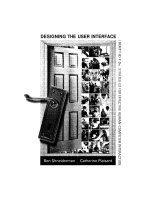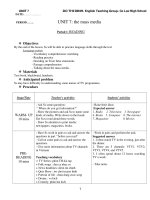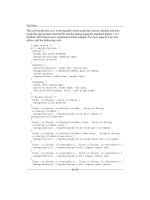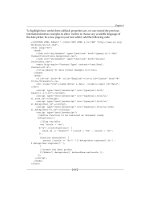jquery ui 1.7 the user interface library
Bạn đang xem bản rút gọn của tài liệu. Xem và tải ngay bản đầy đủ của tài liệu tại đây (8.9 MB, 392 trang )
jQuery UI 1.7
The User Interface Library for jQuery
Build highly interactive web applications with
ready-to-use widgets from the jQuery User
Interface library
Dan Wellman
BIRMINGHAM - MUMBAI
jQuery UI 1.7
The User Interface Library for jQuery
Copyright © 2009 Packt Publishing
All rights reserved. No part of this book may be reproduced, stored in a retrieval
system, or transmitted in any form or by any means, without the prior written
permission of the publisher, except in the case of brief quotations embedded in
critical articles or reviews.
Every effort has been made in the preparation of this book to ensure the accuracy
of the information presented. However, the information contained in this book is
sold without warranty, either express or implied. Neither the author, nor Packt
Publishing, and its dealers and distributors will be held liable for any damages
caused or alleged to be caused directly or indirectly by this book.
Packt Publishing has endeavored to provide trademark information about all of the
companies and products mentioned in this book by the appropriate use of capitals.
However, Packt Publishing cannot guarantee the accuracy of this information.
First published: November 2009
Production Reference: 1021109
Published by Packt Publishing Ltd.
32 Lincoln Road
Olton
Birmingham, B27 6PA, UK.
ISBN 978-1-847199-72-0
www.packtpub.com
Cover Image by Vinayak Chittar ()
Credits
Author
Dan Wellman
Reviewers
Marc Grabanski
Akash Mehta
Jörn Zaefferer
Acquisition Editor
Douglas Paterson
Development Editor
Nikhil Bangera
Technical Editors
Vinodhan Nair
Gagandeep Singh
Indexer
Rekha Nair
Editorial Team Leader
Gagandeep Singh
Project Team Leader
Priya Mukherji
Proofreader
Claire Cresswell-Lane
Graphics
Nilesh Mohite
Production Coordinator
Shantanu Zagade
Cover Work
Shantanu Zagade
About the Author
Dan Wellman lives with his wife and three children in his home town
of Southampton on the south coast of England. By day his mild-mannered
alter-ego works for a small yet accomplished e-commerce production agency.
By night he battles the forces of darkness and ghts for truth, justice, and less
intrusive JavaScript.
He has been writing computer-related articles, tutorials, and reviews for around
ve years and is rarely very far from a keyboard of some description. This is his
third book.
I'd like to thank the Packt editorial team, all of the technical
reviewers and the jQuery UI team, without whom this book would
not have been possible. Special thanks go to Jörn Zaefferer who
provided essential feedback and was always happy to answer my
late-night, niggling questions.
Thanks also to my fantastic friends, in no particular order; Steve
Bishop, Eamon O' Donoghue, James Zabiela, Andrew Herman,
Aaron Matheson, Dan Goodall, Mike Woodford, Mike Newth, John
Adams, Jon Field and Vicky Hammond and all the rest of the guys
and girls.
About the Reviewers
Marc Grabanski got involved early on with jQuery by authoring what would
become the jQuery UI Datepicker. He works, arguably too much, building user
interfaces and web software all the day long with his company MJG International.
If I were to thank anyone it would be Jesus Christ for transforming
me from a video game addict into something useful to society and
the people around me.
Akash Mehta is a web application developer and technical author based in
Australia. His area of work covers e-learning solutions, information systems, and
developer training. He regularly writes web development articles for Adobe, CNet,
the APC Magazine, and other publications in print and online. He is a regular
speaker at IT conferences, user groups, and BarCamps. Currently, Akash provides
web development, technical writing, consulting, and training services through his
website, />I would like to thank my parents, for their constant support and
encouragement, and Sophie, for her enduring patience and
amazing inspiration.
Jörn Zaefferer is a professional software developer from Cologne, Germany.
He creates application programming interfaces (APIs), graphical user interfaces
(GUIs), software architectures, and designs databases, for both web and
desktop applications.
His work focuses on the Java-platform, while clientside-scripting evolves around
jQuery. He started contributing to jQuery in mid-2006, and has since co-created
and maintained QUnit, jQuery's unit testing framework; released and maintained a
half-dozen of very popular jQuery plugins, and contributed to jQuery books as both
author and tech-reviewer. He also is a lead developer for jQuery UI.
This book is dedicated to my eternally patient and understanding wife Tammy and
my beautiful kids Bethany, Matthew, James, and Jessica. Shining supernovas that
light up my life.
Table of Contents
Preface 1
Chapter 1: Introducing jQuery UI 7
Downloading the library 8
Setting up a development environment 10
The structure of the library 11
ThemeRoller 12
Component categories 16
Browser support 17
Book examples 18
Library licensing 18
API introduction 19
Events and callbacks 21
Callback arguments 22
Summary 23
Chapter 2: The CSS Framework 25
The files that make up the framework 25
ui.all.css 26
ui.base.css 27
ui.core.css 27
The individual component framework files 28
ui.theme.css 28
Linking to the required framework files 29
Using the framework classes 30
Containers 30
Interactions 32
Icons 33
Interaction cues 34
Table of Contents
[ ii ]
Switching themes quickly and easily 36
Overriding the theme 37
Summary 40
Chapter 3: Tabs 41
A basic tab implementation 42
Tab CSS framework classes 44
Applying a custom theme to the tabs 46
Configurable options 47
Selecting a tab 49
Disabling a tab 50
Transition effects 50
Collapsible tabs 51
Tab events 52
Binding to events 54
Using tab methods 55
Enabling and disabling tabs 56
Adding and removing tabs 57
Simulating clicks 58
Creating a tab carousel 59
Getting and setting options 61
AJAX tabs 62
Displaying data obtained via JSONP 66
Summary 69
Chapter 4: The Accordion Widget 71
Accordion's structure 72
Styling the accordion 75
Configuring an accordion 77
Changing the trigger event 78
Changing the default active header 78
Filling the height of its container 80
Accordion animation 81
Accordion events 83
The changestart event 84
Accordion navigation 85
Accordion methods 87
Destruction 88
Header activation 89
Accordion interoperability 90
A del.icio.us accordion 92
Summary 96
Table of Contents
[ iii ]
Chapter 5: The Dialog 97
A basic dialog 98
Dialog options 100
Showing the dialog 102
Positioning the dialog 102
The title of the dialog 104
Modality 105
Adding buttons 106
Enabling dialog animations 108
Fixing IE6 109
Configuring the dialog's dimensions 110
Stacking 111
Dialog's event model 113
Controlling a dialog programmatically 116
Toggling the dialog 116
Getting data from the dialog 117
Dialog interoperability 119
A dynamic image-based dialog 120
Summary 126
Chapter 6: Slider 127
Implementing a slider 128
Custom styling 129
Configurable options 130
Creating a vertical slider 130
Minimum and maximum values 131
Slider steps 132
Slider animation 132
Setting the slider's value 133
Using multiple handles 133
The range element 134
Using slider's event API 134
Slider methods 137
Future uses 139
A color slider 141
Summary 144
Chapter 7: Datepicker 145
The default datepicker 146
Configurable options of the picker 148
Basic Options 149
Minimum and maximum dates 151
Table of Contents
[ iv ]
Changing the datepicker UI 152
Adding a trigger button 154
Configuring alternative animations 156
Multiple months 158
Changing the date format 159
Updating an additional input element 162
Localization 162
Callback properties 166
Utility methods 168
Date picking methods 170
Selecting a date programmatically 170
Showing the datepicker in a dialog 171
An AJAX datepicker 172
Summary 176
Chapter 8: Progressbar 177
The default progressbar implementation 178
Using progressbar's configuration option 179
Progressbar's event API 180
Progressbar methods 181
User initiated progress 182
Rich uploads with progressbar 189
Summary 192
Chapter 9: Drag and Drop 193
The deal with drag and droppables 194
Draggables 194
A basic drag implementation 195
Configuring draggable options 197
Using the configuration options 199
Resetting dragged elements 200
Drag handles 201
Helper elements 202
Constraining the drag 205
Snapping 206
Draggable event callbacks 208
Using draggable's methods 211
Droppables 211
Configuring droppables 214
Tolerance 216
Droppable event callbacks 218
Scope 222
Table of Contents
[ v ]
Greedy 224
Droppable methods 228
A drag and drop game 229
Summary 234
Chapter 10: Resizing 235
A basic resizable 236
Resizable options 238
Configuring resize handles 239
Adding additional handle images 240
Defining size limits 241
Resize ghosts 243
Containing the resize 245
Handling the aspect ratio 246
Resizable animations 247
Simultaneous resizing 248
Preventing unwanted resizes 250
Resizable callbacks 250
Resizable methods 252
Resizable tabs 252
Summary 254
Chapter 11: Selecting 255
Basic implementation 256
Selectee class names 258
Configurable options of the selectable component 260
Filtering selectables 260
Cancelling the selection 262
Selectable callbacks 262
Working with vast amounts of selectables 266
Selectable methods 268
A selectable image viewer 270
Styling the image selector 274
Summary 276
Chapter 12: Sorting 277
The default implementation 278
Configuring sortable options 281
Placeholders 287
Sortable helpers 289
Sortable items 290
Connected lists 292
Table of Contents
[ vi ]
Reacting to sortable events 295
Connected callbacks 299
Sortable methods 301
Widget compatibility 304
Adding draggables 306
Sortable page widgets 310
The underlying page 312
Styling the page 313
The main script 314
Building the content boxes 317
Writing the cookie 319
Making the boxes sortable 319
Closing and restoring boxes 320
Summary 321
Chapter 13: UI Effects 323
The core effects file 324
Using color animations 324
Using class transitions 326
Advanced easing 328
Highlighting specified elements 328
Additional effect arguments 331
Bouncing 332
Shaking an element 334
Transferring an element's outline 335
Element scaling 338
Element explosion 341
The puff effect 343
The pulsate effect 345
Dropping elements onto the page 347
Sliding elements open or closed 349
The window-blind effect 353
Clipping elements 354
Folding elements 356
Summary 357
Index 359
Preface
Modern web application user interface design requires rapid development and
proven results. jQuery UI, a trusted suite of ofcial plugins for the jQuery JavaScript
library, gives you a solid platform on which to build rich and engaging interfaces
with maximum compatibility, stability, and a minimum of time and effort.
jQuery UI has a series of ready-made, great looking user interface widgets, and
a comprehensive set of core interaction helpers designed to be implemented in a
consistent and developer-friendly way. With all this, the amount of code that
you need to write personally to take a project from conception to completion is
drastically reduced.
Specially revised for version 1.7 of jQuery, this book has been written to maximize
your experience with the library by breaking down each component and walking
you through examples that progressively build upon your knowledge, taking you
from beginner to advanced usage in a series of easy-to-follow steps.
In this book, you'll learn how each component can be initialized in a basic default
implementation and then see how easy it is to customize its appearance and
congure its behavior to tailor it to the requirements of your application. You'll look
at the conguration options and the methods exposed by each component's API to
see how these can be used to bring out the best of the library.
Events play a key role in any modern web application if it is to meet the expected
minimum requirements of interactivity and responsiveness, and each chapter will
show you the custom events red by the component covered and how these events
can be intercepted and acted upon.
Preface
[ 2 ]
What this book covers
Chapter 1, Introducing jQuery UI, gives a general overview and introduction to
jQuery UI. You nd out exactly what the library is, where it can be downloaded
from, and where resources for it can be found. We look at the freedom the license
gives you to use the library and how the API has been simplied to give the
components a consistent and easy to use programming model.
In Chapter 2, The CSS Framework, we look in details at the extensive CSS framework
that provides a rich environment for integrated theming via ThemeRoller, or allows
developers to easily supply their own custom themes or skins.
In Chapter 3, Tabs, we look at the tabs component; a simple but effective means of
presenting structured content in an engaging and interactive widget.
Chapter 4, The Accordion Widget, looks at the accordion widget, another component
dedicated to the effective display of content. Highly engaging and interactive, the
accordion makes a valuable addition to any web page and its API is exposed in full
to show exactly how it can be used.
In Chapter 5, The Dialog, we focus on the dialog widget. The dialog behaves in the
same way as a standard browser alert, but it does so in a much less intrusive and
more visitor-friendly manner. We look at how it can be congured and controlled to
provide maximum benet and appeal.
Chapter 6, Slider, looks at the slider widget that provides a less commonly used, but
no less valuable user interface tool for collecting input from your visitors. We look
closely at its API throughout this chapter to see the variety of ways that in which it
can be implemented.
In Chapter 7, Datepicker, we look at the datepicker. This component packs a huge
amount of functionality into an attractive and highly usable tool, allowing your
visitors to effortlessly select dates. We look at the wide range of congurations that
its API makes possible as well as seeing how easy common tasks such as skinning
and localization are made.
In Chapter 8, Progressbar, we look at the new progressbar widget; examining its
compact API and seeing a number of ways in which it can be put to good use in our
web applications.
In Chapter 9, Drag and Drop, we begin looking at the low-level interaction helpers,
tackling rst the related drag-and-droppable components. We look at how they
can be implemented individually and how they can be used together for
maximum effect.
Preface
[ 3 ]
Chapter 10, Resizing, looks at the resizing component and how it is used with the
dialog widget from earlier in the book. We see how it can be applied to any element
on the page to allow it be resized in a smooth and attractive way.
In Chapter 11, Selecting, we look at the selectable component, which allows us add
behavior to elements on the page and allow them be selected individually or as a
group. We see that this is one component that really brings the desktop and the
browser together as application platforms.
Chapter 12, Sorting, looks at the nal interaction helper—the sortable component.
This is an especially effective component that allows you to create lists on a page
that can be reordered by dragging items to a new position on the list. This is another
component that can really help you to add a high level of professionalism and
interactivity to your site with a minimum of effort.
Chapter 13, UI Effects, is dedicated solely to the special effects that are included with
the library. We look at an array of different effects that allow you to show, hide,
move, and jiggle elements in a variety of attractive and appealing animations.
There is no 'fun with' section at the end of this chapter; the whole chapter is a
'fun with' section.
What you need for this book
A copy of the latest jQuery UI full build (1.7.2 at the time of writing)
A code or text editor
A browser
The code download for the book
Who this book is for
This book is for developers who want to quickly and easily build engaging,
highly interactive interfaces for their web applications, or less commonly, for
embedded applications.
Nokia was the rst mobile phone company to announce that they were adopting
jQuery to power parts of their cell phone operating system. I'm sure that by the time
this book is published there will be more companies adapting the library for their
own needs, and wherever jQuery goes, jQuery UI can follow.
People who are comfortable with HTML, JavaScript, and CSS along with having at
least some experience with jQuery itself will get the most benet from what this book
has to offer. However, no prior knowledge of the UI library itself is required.
•
•
•
•
Preface
[ 4 ]
Consider the following code:
$("#myEl").click(function() {
$("<p>").attr("id", "new").css({
color:"#000000"
}).appendTo("#target");
)};
If you cannot immediately see, and completely understand, what this simple code
snippet does, you would probably get more from this book after rst learning about
jQuery itself. Consider reading Karl Swedberg and Jonathan Chaffer's excellent
Learning jQuery 1.3, also by Packt Publishing, or visit rningjquery.
com
for an excellent foundation in jQuery, and then come back to this book.
Each jQuery UI specic method or property that we work with will be fully covered
in the explanatory text that accompanies each code example, and where it is
practical, some of the standard jQuery code will also be discussed. CSS and HTML
will take a back seat and be covered very briey, if at all, unless it is completely
central to the discussion at hand.
Basic concepts of using jQuery itself won't be covered. Therefore, you should already
be familiar with advanced DOM traversal and manipulation, attribute and style
getting and setting, and making and handling AJAX calls. You should be comfortable
with the programming constructs exposed by jQuery such as method chaining, using
JavaScript objects, and working with callback functions.
Conventions
In this book, you will nd a number of styles of text that distinguish between
different kinds of information. Here are some examples of these styles, and an
explanation of their meaning.
Code words in text are shown as follows: "We can include other contexts through the
use of the
include directive."
A block of code is set as follows:
[default]
var pickerOpts = {
changeMonth: true,
changeYear: true,
yearRange: "-25:+25"
};
Preface
[ 5 ]
When we wish to draw your attention to a particular part of a code block, the
relevant lines or items are set in bold:
[default]
var pickerOpts = {
minDate: new Date(),
maxDate: "+10"
};
New terms and important words are shown in bold. Words that you see on the
screen, in menus or dialog boxes for example, appear in the text like this: "clicking
the Next button moves you to the next screen".
Warnings or important notes appear in a box like this.
Tips and tricks appear like this.
Reader feedback
Feedback from our readers is always welcome. Let us know what you think about
this book—what you liked or may have disliked. Reader feedback is important for us
to develop titles that you really get the most out of.
To send us general feedback, simply send an email to
, and
mention the book title via the subject of your message.
If there is a book that you need and would like to see us publish, please
send us a note in the SUGGEST A TITLE form on
www.packtpub.com or
If there is a topic that you have expertise in and you are interested in either writing
or contributing to a book on, see our author guide on
www.packtpub.com/authors.
Customer support
Now that you are the proud owner of a Packt book, we have a number of things to
help you to get the most from your purchase.
Preface
[ 6 ]
Downloading the example code for the book
Visit to
directly download the example code.
The downloadable les contain instructions on how to use them.
Errata
Although we have taken every care to ensure the accuracy of our content, mistakes do
happen. If you nd a mistake in one of our books—maybe a mistake in the text or the
code—we would be grateful if you would report this to us. By doing so, you can save
other readers from frustration, and help us to improve subsequent versions of this
book. If you nd any errata, please report them by visiting
ktpub.
com/support
, selecting your book, clicking on the let us know link, and entering the
details of your errata. Once your errata are veried, your submission will be accepted
and the errata added to any list of existing errata. Any existing errata can be viewed by
selecting your title from
/>Piracy
Piracy of copyright material on the Internet is an ongoing problem across all media.
At Packt, we take the protection of our copyright and licenses very seriously. If you
come across any illegal copies of our works, in any form, on the Internet, please
provide us with the location address or web site name immediately so that we can
pursue a remedy.
Please contact us at
with a link to the suspected
pirated material.
We appreciate your help in protecting our authors, and our ability to bring you
valuable content.
Questions
You can contact us at if you are having a problem with
any aspect of the book, and we will do our best to address it.
Introducing jQuery UI
Welcome to jQuery UI 1.7: The User Interface Library for jQuery. This resource
aims to take you from your rst steps to an advanced usage of the JavaScript library
of UI widgets and interaction helpers built on top of the hugely popular and
easy-to-use jQuery.
jQuery UI extends the underlying jQuery library to provide a suite of rich and
interactive widgets along with code-saving interaction helpers, built to enhance the
user interfaces of your websites and web applications. It's the ofcial UI library for
jQuery and although it is not the only library built on top of jQuery, in my opinion it
is without a doubt the best.
jQuery has quickly become one of the most popular JavaScript libraries in use today
and jQuery UI will denitely become the extension library of choice, thanks to its
ever-growing range of common UI widgets, high levels of congurability, and its
exceptional ease of implementation.
jQuery UI runs on top of jQuery and hence the syntax used to initialize, congure,
and manipulate the different components is in the same comfortable, easy-to-use
style as jQuery. We automatically get all of the great jQuery functionality at our
disposal as well. The library is also supported by a range of incredibly useful tools,
such as the CSS framework that provides a range of helper CSS classes, and the
excellent ThemeRoller application that allows us to visually create our own custom
themes for the widgets.
Over the course of this book we'll look at each of the existing components that make
up the library. We will also be looking at their conguration options and trying out
their methods in order to fully understand how they work and what they are capable
of. By the end of the book, you'll be an expert in its implementation.
We already have a basic working knowledge of the components when we add a
new component because of the consistency in how we implement the different
components that make up the library. Therefore, we only need to learn any
widget-specic functionality.
Introducing jQuery UI
[ 8 ]
This chapter will cover the following topics:
How to obtain a copy of the library
How to set up a development environment
The structure of the library
ThemeRoller
The format of the API
Browser support
How the library is licensed
Downloading the library
To obtain a copy of the library, we should visit the download builder at
which gives us a range of different options for
building a download package that is tailored for our particular implementational
requirements. The following screenshot shows the download builder:
•
•
•
•
•
•
•









